Ligue Des Champions, known in English as the UEFA Champions League, stands as the crowning jewel of club football in Europe. Established in 1955, this prestigious tournament has evolved into one of the most celebrated sporting events globally, showcasing the continent’s top clubs and players. As fans eagerly anticipate each season, the Champions League captivates millions with its thrilling matches, rich history, and high stakes. This article delves into the tournament’s origins, its format, the significance of its matches, and its cultural impact on football and beyond.
The Origins and Evolution of Ligue Des Champions
The UEFA Champions League’s origins can be traced back to the mid-20th century when the idea of a European club competition gained traction. Originally known as the European Cup, the tournament was founded by the European football governing body, UEFA, to create a platform for Europe’s best teams to compete against one another. The inaugural tournament kicked off in 1955, featuring 16 clubs, including iconic teams like Real Madrid, AC Milan, and Celtic.
Real Madrid emerged as the inaugural champions, setting a precedent for future success in the competition. The club went on to dominate the early years of the tournament, winning the first five editions, a record that remains unchallenged. This initial success not only solidified Real Madrid’s status as a football powerhouse but also established the Champions League as a prestigious competition that would capture the imagination of fans and players alike.
Over the decades, the tournament underwent significant changes to adapt to the evolving landscape of European football. In 1992, the European Cup was rebranded as the UEFA Champions League, introducing a new format that included a group stage, allowing more teams to participate and increasing the number of matches played. This change not only enhanced the tournament’s appeal but also elevated the level of competition, as clubs from various nations vied for supremacy.
The Format of the Tournament
The UEFA Champions League format consists of several stages, each designed to test the skills and resolve of participating clubs. The tournament typically begins with a qualification phase, where lower-ranked teams compete for a spot in the group stage. This phase adds an element of suspense and drama, as clubs fight for a chance to join Europe’s elite.
Once the group stage begins, 32 teams are divided into eight groups of four. Each team plays home and away matches against the others in their group, with the top two teams from each group advancing to the knockout stage. The group stage is characterized by intense rivalries and thrilling encounters, as clubs aim to secure their place in the next round.
The knockout stage, which includes the Round of 16, quarter-finals, semi-finals, and the final, is where the competition truly heats up. In this format, each match is do-or-die, with teams competing in two-legged ties, except for the final, which is a single match held at a neutral venue. The knockout stage brings together the best clubs in Europe, resulting in high-stakes matches that often produce memorable moments and dramatic finishes.
The grand finale, the Champions League final, is one of the most-watched sporting events worldwide. Held in prestigious stadiums across Europe, the final attracts millions of viewers who tune in to witness the culmination of a season’s worth of competition. The winner not only claims the coveted trophy but also secures a place in the history of the tournament, along with the prestige and financial rewards that accompany victory.
The Players and Clubs That Define the Tournament
Ligue Des Champions has been graced by some of the greatest players and clubs in football history. Legendary figures such as Diego Maradona, Johan Cruyff, Lionel Messi, and Cristiano Ronaldo have left indelible marks on the tournament, each contributing to its rich narrative.
Clubs like Real Madrid, FC Barcelona, AC Milan, and Bayern Munich have established themselves as powerhouses in the competition. Real Madrid, in particular, holds the record for the most Champions League titles, a testament to its dominance and tradition of excellence. The fierce rivalries between these clubs add layers of intrigue to the tournament, as their encounters often have a significant impact on both domestic and European standings.
Emerging clubs have also made their mark in recent years, proving that success in the Champions League is not solely reserved for traditional giants. Teams like Manchester City, Paris Saint-Germain, and Chelsea have invested heavily in talent and infrastructure, aiming to disrupt the established order. This influx of competition has enhanced the tournament’s unpredictability, making each season a compelling spectacle.
The individual brilliance of players is often what sets the Champions League apart. Iconic performances, stunning goals, and pivotal saves have defined matches and created unforgettable memories. The tournament has a unique ability to elevate players, showcasing their skills on a grand stage and solidifying their legacies in the annals of football history.
The Cultural Impact of Ligue Des Champions
Beyond the realm of football, Ligue Des Champions exerts a significant cultural influence, shaping narratives and fostering connections among fans worldwide. The tournament’s global reach has transformed it into a cultural phenomenon, transcending borders and languages. Fans from diverse backgrounds come together to celebrate their favorite clubs and players, creating a shared sense of community.
The Champions League final, in particular, has become a cultural event in its own right. It attracts not only die-hard football enthusiasts but also casual viewers and celebrities, transforming the match into a spectacle that goes beyond the sport. Pre-match festivities, halftime shows, and post-match celebrations contribute to the overall experience, making it a highlight of the sporting calendar.
The tournament also plays a crucial role in shaping footballing culture. The style of play, tactics, and philosophies employed by participating clubs influence aspiring players and coaches globally. The Champions League often serves as a testing ground for innovative strategies, pushing teams to adapt and evolve in pursuit of success. The excitement surrounding tactical battles adds another layer of intrigue, as fans analyze formations, substitutions, and game plans.
Moreover, Ligue Des Champions has a profound economic impact, generating significant revenue for clubs, broadcasters, and host cities. The tournament’s lucrative broadcasting rights and sponsorship deals contribute to the financial sustainability of participating clubs, allowing them to invest in talent and infrastructure. The influx of tourists and fans to host cities during the final boosts local economies, highlighting the tournament’s broader impact.
The Future of Ligue Des Champions
As football continues to evolve, so too will the UEFA Champions League. The tournament must adapt to the changing landscape of the sport, including the emergence of new technologies, shifts in fan engagement, and evolving financial dynamics.
The integration of technology into the game, such as VAR (Video Assistant Referee), has already made an impact on how matches are officiated. As technology continues to advance, it may play an even more prominent role in enhancing the fan experience, providing deeper insights into matches, and improving decision-making.
Fan engagement is also set to evolve, with clubs increasingly leveraging digital platforms and social media to connect with supporters. Enhanced interaction through live streaming, behind-the-scenes content, and virtual experiences can further enrich the fan experience, ensuring that the tournament remains relevant in a rapidly changing world.
Furthermore, the growing emphasis on sustainability and social responsibility in sports will likely shape the future of the Champions League. As environmental concerns become more pressing, the tournament may adopt initiatives that promote sustainability, both in operations and fan engagement. This shift not only aligns with global trends but also appeals to a younger, more socially conscious audience.
The competitive landscape of European football is also likely to change, with emerging clubs challenging the established hierarchy. As financial disparities widen, new clubs may rise to prominence, shaking up the status quo and adding further excitement to the tournament.
Conclusion
Ligue Des Champions encapsulates the essence of football excellence, bringing together the finest clubs and players from across Europe in a thrilling competition that captivates millions. With its rich history, evolving format, and cultural significance, the tournament remains a symbol of passion, rivalry, and achievement in the world of sports.
As fans eagerly await each new season, the anticipation for unforgettable moments, dramatic matches, and iconic performances continues to grow. The UEFA Champions League not only showcases the best of football but also serves as a platform for connection, community, and shared experiences. In a world where the love of the game unites people from diverse backgrounds, Ligue Des Champions stands as a testament to the enduring appeal of football and its power to inspire generations.



